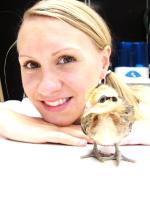Social behaviour responses in red junglefowl (Gallus gallus) selected for tameness
Master's thesis project; Applied Ethology and Animal Behaviour 2010

One of the main characteristics of early domestication was selection for tameness towards humans. The change in selection pressure is often associated with a cascade of responses in traits not intentionally selected for. This induced behavioural changes in the animals, probably either due to pleiotropy or linked genes.
The red junglefowl is the wild ancestor to all domesticated chickens. The domestication process of chicken (Gallus gallus) was initiated around 8000 years ago and led to changes in morphology, physiology and behaviour.
The aim of the study was to evaluate potential changes in the social behaviour towards conspecifics in red junglefowl selected for tameness towards humans. Behavioural differences between males and females were also investigated.
Abstract
Historically during domestication of animals, tameness towards humans was likely the most desired trait and therefore bred on. The red junglefowl (Gallus gallus) is the wild progenitor of all domestic chicken breeds and earlier studies present clear morphological, physiological and behavioural differences between domesticated breeds and the non-domesticated red junglefowl. These changes may be the result of altered gene expression - pleiotropy or linked genes. The aim of this thesis was to evaluate (1) effects of tameness selection on social behaviour towards conspecifics and (2) social behaviour differences between the sexes. Two generations of red junglefowl, P0 and its offspring F1, were studied. Both generations were divided into three selection lines (tame, intermediate or fearful), depending on their results in a fear of humans test. A novel type of social reinstatement test was set up, containing a non-social area without stimulus, and a social area containing a mirror serving as stimulus animals. The social and aggressive behaviours performed towards the mirror were recorded, so was the time spent in the social versus non-social part. An undisturbed behaviour test was performed, as well as a standardized social reinstatement test. The P0-females performed significantly more social behaviour (p=0.008) at 26 weeks than males in the mirror test, and females also displayed significantly more social (p=0.04) and agonistic behaviour (p<0.001) than males in the undisturbed behaviour test. The social reinstatement test displayed a significant effect between the selection lines with regards to sociality. This suggests that there are immediate selection responses in early domestication.
Responsible for this page:
Director of undergraduate studies Biology
Last updated:
05/18/10
